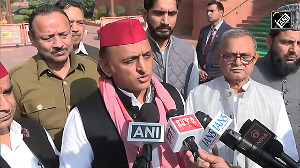It was exactly a year ago that Arjun N Murti predicted that crude oil prices were headed towards the $150-$200 mark. And it was not due to 'speculative excess,' the Goldman Sachs analyst said in a report which he lead-authored.
The price rise seemed to reflect a true play of demand and supply factors since there were no indications of excess supply in the market, according to him.
The same fundamental shifts in demand and supply factors were used to explain the food price shock that accompanied the oil price shock.
It was also one year ago that the then US President George Bush blamed rising food demand from the Indian middle class for food inflation. Developing countries, in turn, pointed out how food inflation was also linked to high oil prices via biofuels -- high oil prices meant more demand for biofuels which is where edible food was being diverted to.
The rising oil price trend, however, reversed before it even reached the $150-a-barrel mark. The record for peak oil price was set on July 11, 2008 when the price touched $147 per barrel.
Prices slid by almost a fifth to a record low of $32 a barrel on December 19 before settling down into a $40-$50-a-barrel band.
No one foresaw such a sharp slide. R S Sharma, the head of the country's largest oil exploration and production company, Oil and Natural Gas Corporation, publicly stated that he did not expect prices to recede from triple-digit levels.
Rewind a little more, to December 1, 2006 and this is what Goldman Sachs predicted: "We expect the world will experience a happy slowdown in 2007."
It expected US growth rates to be below trend over the year but expected this to be offset by healthy growth in Europe, the BRIC economies and Japan. Goldman Sachs, therefore, projected world economic growth at 4.1 per cent in 2007 and 4.3 per cent in 2008.
"The slowdown is also happy in the sense that a rebalancing of global growth away from the US would help to reduce some of the existing global imbalances and would put the world economy on a stronger footing," it said.
This decoupling, however, did not sustain in the face of the sub-prime debris which rippled across the world.
Global output grew by 3.2 per cent in 2008 and, according to the latest estimates of the International Monetary Fund, the world economy is projected to shrink by 1.3
This would make it the largest recession since the Second World War. The position may deteriorate further as the impact of swine flu is factored in.
Back in India, the stock market crossed one milestone after another and the Sensex touched the 21,000 mark in January 2007, with the journey from 20,000 to 21,000 taking just 49 days.
Investors were asking when the 30-share index would reach the 30,000 mark. The reality check: Sensex went down to four-digit levels and crossed the 12,000 mark on Monday.
The projections for the rupee have also been way off the mark, to say the least. So a company like HCL Technologies took a Rs 200 crore (Rs 2 billion) hit in the January-March quarter as it has hedged $1.3 billion at Rs 41 to a dollar.
Maruti Suzuki India took a hit of Rs 121 crore (Rs 1.21 billion) as it too bet on a stronger rupee. A year ago (on May 5), the reference rate of the Reserve Bank of India for the dollar was Rs 40.55. This rate was at Rs 48.73 on January 1, 2009. The reference rate was at Rs 49.68 on Monday.
In so far as the GDP growth was concerned, there were stretch targets, articulated by the Prime Minister, of taking it to double digits. From a growth of 7.5 per cent in 2004-05, the country accelerated to a growth of 9.5 per cent in 2005-06 and to 9.7 per cent in 2006-07.
Just when a double-digit growth seemed within grasp, there was a slippage to 9 per cent in the subsequent year and in the last year, growth has been pretty tempered at 7.1 per cent.
The optimistic estimates for growth in the current year are in the 7-7.5 per cent range while the lowest growth estimate for the country is at 4.5 per cent from the IMF.
The sanctity of projections which need to be revised with every additional bit of information that comes into the public arena is, therefore, suspect.
There also seems to be a herd mentality when it comes to making these forward-looking statements, which drowns out the fringe voices which have as much a chance of being right as the majority voices.
There were analysts and consultants and even finance ministers who were asking if the steep hike in oil prices was justified by the fundamentals but they weren't the ones who dominated the airwaves.
The challenging task for the non-expert then is to pick up the right experts to follow, and these are not necessarily the ones who make the most noise!






